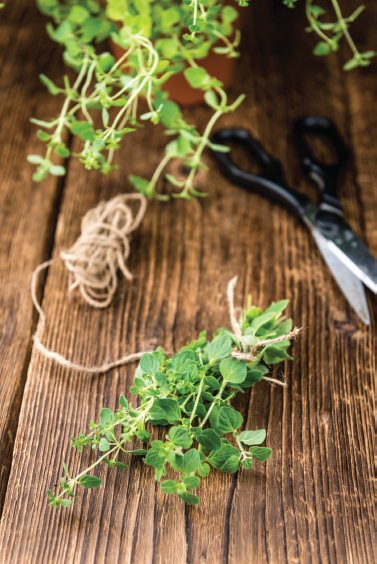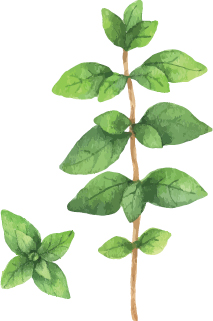

The Plant
Oregano and marjoram are related—how closely is a subject of debate among botanists. For culinary purposes, it is enough to know that they are similar in their growth and flavor. They are distinguishable in the way they look and taste, yet they are interchangeable in cooking.
Oregano is a hardy perennial that tends to sprawl. Its dark green leaves are rounded; in late summer it blooms pinkish-purple flowers.
Marjoram is a smaller plant and more viny. Although it is a perennial, it behaves more like an annual since it cannot survive hard winters. Its leaves are oval, and it produces little knotty nodes along its stems, a telltale difference from oreganos.
The Flavor
Fresh oregano resembles thyme and balsam in its flavor. When dried, it is sharper, full of zest, quite pungent, and even piney.
Marjoram has echoes of mint and an edge of sweetness, followed immediately by a slight bitterness.
Growing Needs
Neither oregano nor marjoram are fussy about soil makeup as long as it is well drained. They do prefer a lot of sun and a moderate amount of water.
They develop fuller stalks and lush growth when they are routinely trimmed back.
You can start the plants from seed. You will be less discouraged if you being with a cutting or a stalk and a root that have been divided from a mature plant.
The flavors of both oregano and marjoram are the brightest when the leaves are cut just before the plants bloom. Use them fresh, or cut the branches at this stage for drying.
Storage
To preserve some of these herbs’ fresh flavors, chop the leaves and stir them into olive oil. Refrigerate the mixture; then use it over pastas and pizzas.
Put fresh leaves in plastic bags and refrigerate or freeze them. Chop fresh leaves, place in ice cube trays with water, and freeze.
Hang stems of oregano and marjoram in bunches, upside down in a dry, well ventilated area. Or lay the branches on screens to dry.
When the leaves have fully dried, strip them off the stems into airtight containers.
Culinary Suggestions
Oregano zips up the taste of any tomato-based dish. Especially in its dry form, it can overtake a plate, so go lightly! Soups, stews, meats, and poultry can all benefit by the addition of oregano.
Add oregano or marjoram or both to salad dressings and to Italian, Mexican, and Greek dishes.
Marjoram complements bean recipes of almost any variety, as well as lamb and egg and stuffing dishes.

Distinguishing Qualities
Marjoram is milder, sweeter, and subtler than oregano. Yet both bring a piney, somewhat sharp twist to whatever dish they join.
Tips
Dried oregano carries more punch than fresh.
Dried marjoram offers a sweeter bouquet and flavor than fresh.
A marjoram branch bearing leaves and knots brings flavor—and visual interest—to a jar of vinegar.
If you want to add either herb in its fresh form to a cooked or baked dish, add it at or near the end of the heating process to maximize its fresh taste.